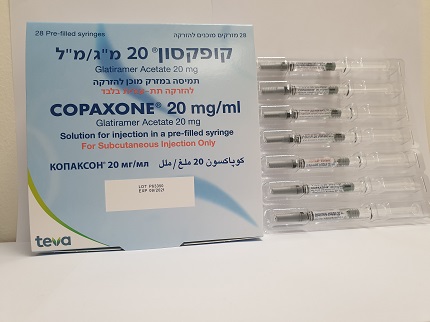Quest for the right Drug

קופקסון 20 מ"ג/מ"ל COPAXONE 20 MG/ML (GLATIRAMER ACETATE)
תרופה במרשם
תרופה בסל
נרקוטיקה
ציטוטוקסיקה
צורת מתן:
תת-עורי : S.C
צורת מינון:
תמיסה להזרקה : SOLUTION FOR INJECTION
עלון לרופא
מינוניםPosology התוויות
Indications תופעות לוואי
Adverse reactions התוויות נגד
Contraindications אינטראקציות
Interactions מינון יתר
Overdose הריון/הנקה
Pregnancy & Lactation אוכלוסיות מיוחדות
Special populations תכונות פרמקולוגיות
Pharmacological properties מידע רוקחי
Pharmaceutical particulars אזהרת שימוש
Special Warning עלון לרופא
Physicians Leaflet
Special Warning : אזהרת שימוש
4.4. Special warnings and precautions for use Copaxone should only be administered subcutaneously. Copaxone should not be administered by intravenous or intramuscular routes. The treating physician should explain to the patient that a reaction associated with at least one of the following symptoms may occur within minutes of a Copaxone injection: vasodilatation (flushing), chest pain, dyspnoea, palpitations or tachycardia. The majority of these symptoms is short-lived and resolves spontaneously without any sequelae. Should a severe adverse event occur, the patient must immediately stop Copaxone treatment and contact his/her physician or any emergency doctor. Symptomatic treatment may be instituted at the discretion of the physician. There is no evidence to suggest that any particular patient groups are at special risk for these reactions. Nevertheless, caution should be exercised when administering Copaxone to patients with pre-existing cardiac disorders. These patients should be followed up regularly during treatment. Convulsions and/or anaphylactoid or allergic reactions have been reported rarely. Serious hypersensitivity reactions (e.g. bronchospasm, anaphylaxis or urticaria) may rarely occur. If reactions are severe, appropriate treatment should be instituted and Copaxone should be discontinued. Glatiramer acetate-reactive antibodies were detected in patients’ sera during daily chronic treatment with Copaxone. Maximal levels were attained after average treatment duration of 3-4 months and, thereafter, declined and stabilised at a level slightly higher than baseline. There is no evidence to suggest that these glatiramer acetate-reactive antibodies are neutralising or that their formation is likely to affect the clinical efficacy of Copaxone. In patients with renal impairment, renal function should be monitored while they are treated with Copaxone. Whilst there is no evidence of glomerular deposition of immune complexes in patients, the possibility cannot be excluded. Rare cases of severe liver injury have been observed (including hepatitis with jaundice, liver failure, and in isolated cases liver transplantation). Liver injury occurred from days to years after initiating treatment with Copaxone. Most instances of severe liver injury resolved with discontinuation of treatment. In some cases, these reactions have occurred in the presence of excessive alcohol consumption, existing or history of liver injury and use of other potentially hepatotoxic medication. Patients should be regularly monitored for signs of hepatic injury and instructed to seek immediate medical attention in case of symptoms of liver injury. In case of clinically significant liver injury, discontinuation of Copaxone should be considered.
Effects on Driving

פרטי מסגרת הכללה בסל
א. התרופה תינתן לטיפול בחולים עם אבחנה וודאית של טרשת נפוצה (על פי הקריטריונים העדכניים על שם McDonald) עם מחלה פעילה או Clinically Isolated Syndrome (CIS), בהתאם לתנאי הרישום.הטיפול לא יינתן לחולים עם מחלה פרוגרסיבית ראשונית (PPMS) או פרוגרסיבית שניונית פעילה (SPMS) שאינם מטופלים בתרופות ייעודיות לטרשת נפוצה.ב. הטיפול יינתן כמונותרפיה.ג. התחלת הטיפול בתרופה תיעשה לפי מרשם של נוירו אימונולוג שעבר השתלמות עמיתים, או נוירולוג ילדים שעבר השתלמות עמיתים בטרשת נפוצה, או מומחה בנוירולוגיה העובד במרפאת טרשת נפוצה או מרפאה נוירואימונולוגית ייעודית.
מסגרת הכללה בסל
התוויות הכלולות במסגרת הסל
| התוויה | תאריך הכללה | תחום קליני | Class Effect | מצב מחלה |
|---|---|---|---|---|
| א. התרופה תינתן לטיפול בחולים עם אבחנה וודאית של טרשת נפוצה (על פי הקריטריונים העדכניים על שם McDonald) עם מחלה פעילה או Clinically Isolated Syndrome (CIS), בהתאם לתנאי הרישום. הטיפול לא יינתן לחולים עם מחלה פרוגרסיבית ראשונית (PPMS) או פרוגרסיבית שניונית פעילה (SPMS) שאינם מטופלים בתרופות ייעודיות לטרשת נפוצה. ב. הטיפול יינתן כמונותרפיה. ג. התחלת הטיפול בתרופה תיעשה לפי מרשם של נוירו אימונולוג שעבר השתלמות עמיתים, או נוירולוג ילדים שעבר השתלמות עמיתים בטרשת נפוצה, או מומחה בנוירולוגיה העובד במרפאת טרשת נפוצה או מרפאה נוירואימונולוגית ייעודית. | 03/02/2022 | נוירולוגיה | טרשת נפוצה, Multiple sclerosis | |
| התרופה האמורה תינתן לטיפול במקרים האלה: א. טרשת נפוצה, ובהתקיים כל התנאים האלה (התוויה כלולה בסל): (1) החולה מאובחן כסובל מטרשת נפוצה מסוג נסיגה נשנית (relapsing remitting) בלבד; (2) למחלה ניתנה אבחנה קלינית מוגדרת (clinically definite) או אבחנה הנתמכת בבדיקת מעבדה (laboratory supported definite); (3) החולה בעל כושר תנועה ואינו זקוק לתמיכה קבועה לצורכי ניידות (5.5EDSS | 03/01/2010 | נוירולוגיה | טרשת נפוצה, Multiple sclerosis | |
| 01/06/1997 | נוירולוגיה | טרשת נפוצה, Multiple sclerosis |
שימוש לפי פנקס קופ''ח כללית 1994
לא צוין
תאריך הכללה מקורי בסל
01/06/1997
הגבלות
תרופה מוגבלת לרישום ע'י רופא מומחה או הגבלה אחרת
מידע נוסף
עלון מידע לצרכן
11.06.20 - עלון לצרכן 26.10.16 - עלון לצרכן אנגלית 11.06.20 - עלון לצרכן עברית 26.10.16 - עלון לצרכן ערבית 31.10.23 - עלון לצרכן עברית 07.11.23 - עלון לצרכן אנגלית 07.11.23 - עלון לצרכן עברית 07.11.23 - עלון לצרכן ערבית 11.06.20 - החמרה לעלון 11.06.20 - החמרה לעלון 31.10.23 - החמרה לעלוןלתרופה במאגר משרד הבריאות
קופקסון 20 מ"ג/מ"ל